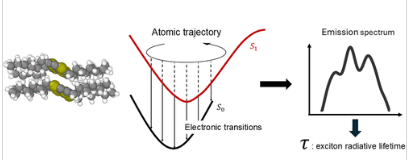Cheick Oumar Diarra, Julien Taillieu, Mauro Boero, Thomas Heiser, Evelyne Martin
Organic photovoltaic (OPV) technology offers a solution to the global demand for sustainable energy production and harvesting due to its affordability, versatility, and moderate environmental impact. Recent advancements have led to an increased efficiency in bulk heterojunction (BHJ) solar cells, making practical applications feasible. However, these advancements have also raised fundamental questions regarding exciton transport mechanisms. A precise understanding of the relationship between the exciton diffusion length and material structure is crucial for improvements and applications. We formerly assessed a method to extract the exciton diffusion coefficient [Diarra, C. O. Phys. Chem. Chem. Phys. 2023, 25, 15539–15546] via first-principles dynamical simulations in the excited state. Here, we propose a novel approach to compute the radiative lifetime using the same method. This provides an additional crucial parameter contributing to the exciton diffusion length. We benchmark the validity of the method on a specific semiconducting polymer, poly(3-hexylthiophene) (P3HT). The resulting exciton diffusion length is found to be in close agreement with the available experimental data.
